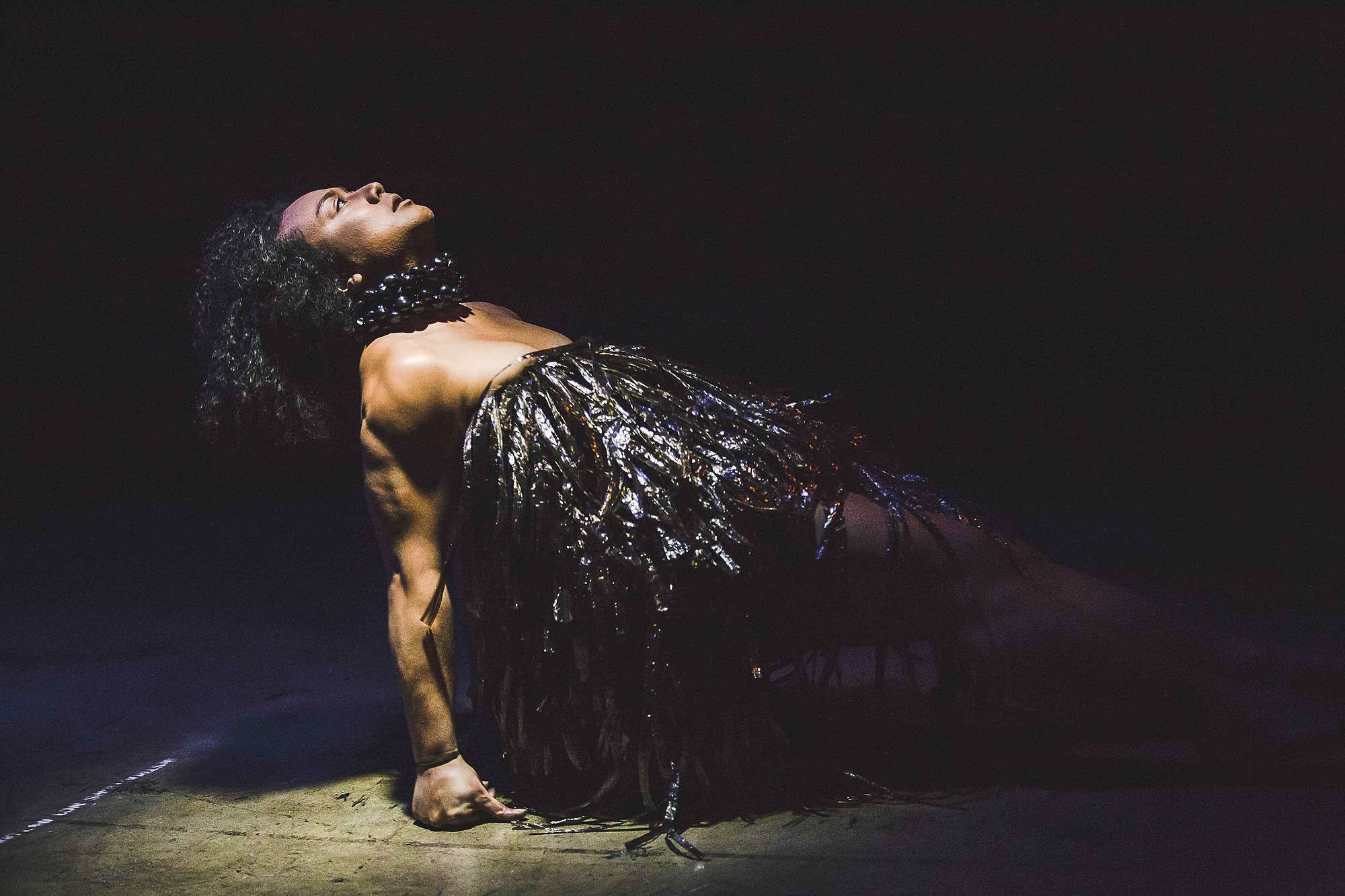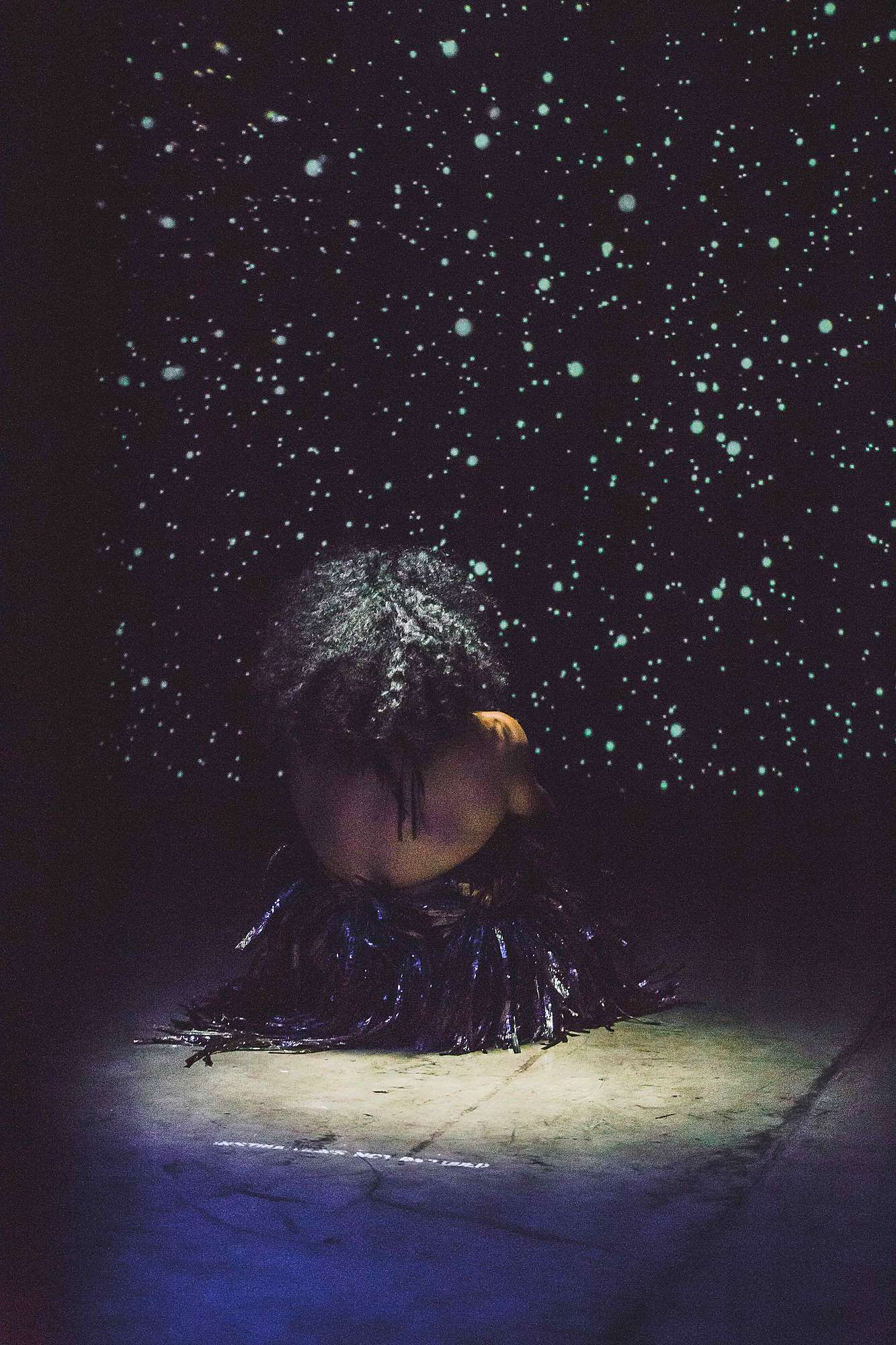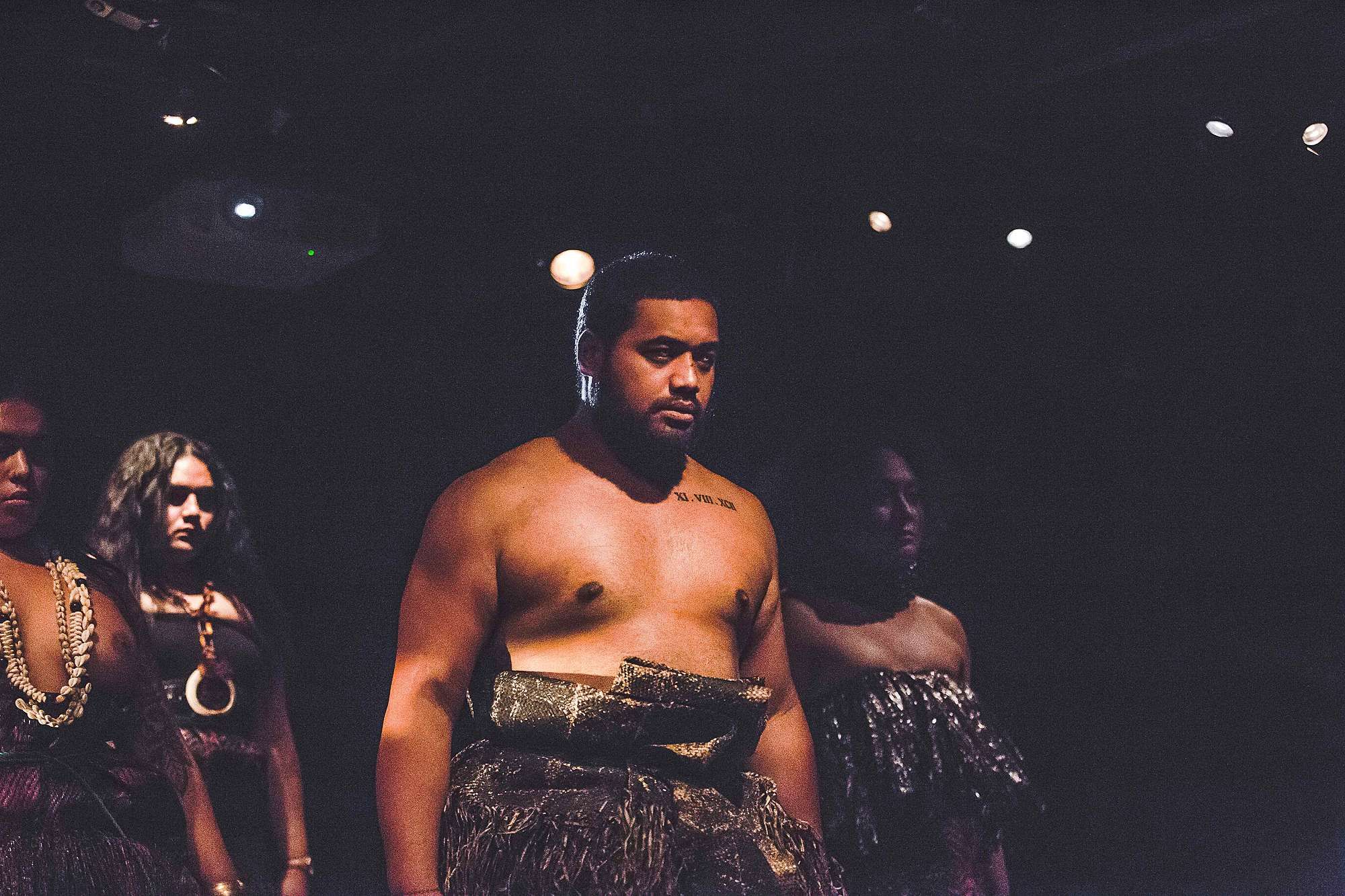Challenging Borders: A Review of Fa’aafa
The laying down of a challenge and the space between. Jahra Wasasala reviews Fa'aafa.
The laying down of a challenge and the space between; Jahra Wasasala reviews Fa'aafa.
Fa’aafa is a new striking performance work from the multi-disciplinary artist Pati Solomona Tyrell. Produced by queer-Pacific art collective, FAFSWAG, its debut season has just opened at the artist-community focused Basement Theatre. Fa’aafa draws from Samoan oral traditions, adornment, movement and sound that converses with, and pushes against, modern digital projection that provides a glimpse into another realm. A realm familiar, yet foreign, to this one we know as reality. This genre-bending work features the artists Moe Laga, Joey Tinai, and Falencie Filipo, as well as poetry from the critically-acclaimed Samoan poet, Tusiata Avia. Director Pati Solomona Tyrell says this work “unveils a world known only to Samoans through whispers.”
When I was first asked to review Fa’aafa, my gut dropped slightly. I’m not a traditional reviewer. I’m not a reviewer in general. I’m not really a traditional anything. And reviewing, as a form of translating mahi is something I don’t personally align with anymore. Responses, however, have an important and needed role within indigenous arts spaces, wider creative arts communities and general performance environments. So, let’s deconstruct this ‘review’ a little, in typical ‘Rager’ fashion!
My name is Jahra ‘Rager’ Wasasala. I am a mixed-race, female Oceanic artist of Fijian decent. A daughter of diaspora. I am a trained contemporary dancer, poet and performance artist.
As much as an other-worldly work can, the world of Fa’aafa (the term being a Samoan conception of ‘half’) pushes the edges of the black box theatre by simply being present within the prescribed space. As someone who works with sacred states within modern and western techniques and ‘performance spaces’, I still feel that the appropriate space to hold this kind of work is yet to manifest. Yet in the meantime, presenting work like Fa’aafa in these contemporary theatre spaces, including galleries and studios, decolonises these white environments.
As the audience enters the space, the theatre is pushed into being in traverse, already vying away from the traditional structure of a end-on configuration. With the Basement Theatre being the black box that it is, I am instantly transported into the Va. The Va, as defined by prolific writer and poet Albert Wendt, is “the space between, the betweenness, not empty space, not space that separates but space that relates, that holds separate entities and things together in the unity-that-is-all, the space that is context, giving meaning to things.” The Va can translate into the spiritual origin that exists before what we know as our ‘human beginning’. And because of this considered physical state we are ushered into, I feel that me, and all who are ancestrally behind me, have a place in this space.
And because of this considered physical state we are ushered into, I feel that me, and all who are ancestrally behind me, have a place in this space.
Upon entering, performer Moe Laga lies in the centre of the space, almost as an offering of a vessel for something more divine to wake to and work through, which feels like a motif and central belief throughout Fa’aafa. Laga’s form begins dormant in physicality, but her mere presence activates the space. Projected eyes from an unknown being watch her, and us. And as Laga moves, awakens, and sometimes violently calls upon her body to come into consciousness, the realm surrounding her begins to converse back.
Fa’aafa begins, and lives, as a portal into five states within a realm where the gods have always walked. A realm that most people are either conditioned out of experiencing, or are afraid of conversing with. Fa’aafa serves as more of an ‘acti-VA-tion’ rather than a performance. (The term ‘acti-VA-tion’ was coined by the iconic and prolific Pacific performance artist, Rosanna Raymond, who Tyrell cites as being an influence on his mahi.) Utilising the various art forms of movement, adornment, concentrated lighting colours, film projection, poetry and sound both chanted and pre-recorded, Fa’aafa offers the audience, or rather witnesses, fragments of an old language we have been stripped of but are in the process of remembering and interpreting.
A body realising itself in the present whilst warping and pushing traditional and ancient movement is an important event, a disruption in itself.
As a contemporary dancer who consumes contemporary dance shows, I am constantly over-saturated with a flurry of wild and limitless movement, flashy (and sometimes unnecessary) tricks, dense multiple techniques and worldly physical languages. Yet, throughout Fa’aafa the movement is powerful, refreshing and present. To watch the artists’ bodies that are ancestrally influenced performing movement that is considered, placed, potent, tender and violent is almost meditative. A body realising itself in the present whilst warping and pushing traditional and ancient movement is an important event, a disruption in itself. I am reminded of the various languages and histories associated with different bodies, especially those of the Moana, and how much these forms have influenced movement and dance in Aotearoa. Even when they are not always recognised as such.
As the world of Fa’aafa progresses, the space where the ancient voice and the ‘urban’ body meets is blurred and magnified. Both physically, with this world being activated on a concrete floor and concrete walls, and metaphorically. This feels so close to translating the experience that many people from indigenous nations have with navigating fluid ancestral knowledge through a fixed concrete environment. Throughout this navigation of what is man-made, we move through different realms representative of the natural elements that heavily influence Tyrell as an artist and that inevitably influence us all.
Through the energies working through the Pacific bodies of Tyrell, and Tinai, I feel the earth softly roll beneath me. Through the energies working through the Pacific body of Tyrell under the heat of such vivid red lighting, as he lifts the veil from his own body, I feel a slow burn on my skin. Through the energies working through the Pacific bodies of Filipo, Laga and Tinai, and the voice of Avia, I am brought into my own body to challenge its borders, reckon with my learnt shame and love its historical oceanic endlessness. Through the energies working through the Pacific bodies of Tyrell, Laga, Tinai and Filipo, I witness a celebration, a warning, and a summoning of what will unfold after the activation has finished, maybe even beyond our awareness.
Fa’aafa should be witnessed in its current potent, challenging, considered and beautiful incarnation.
Throughout Fa’aafa, we are welcomed, and simultaneously challenged, by these gods, goddesses, divine humans and entities that roam within our Pacific pantheon; one that many of us who hail from the Moana have been separated from, but have an instinctual calling to return to. I commend and affirm Tyrell, FAFSWAG and all the artists involved for unapologetically putting this offering forward.
Fa’aafa should be witnessed in its current potent, challenging, considered and beautiful incarnation. But this work, as well as all the artists involved, should be invested in and witnessed on a deeper level as they continue to unfold their voices, their bodies, and their worlds in front of us and in front of those who ancestrally walk with us.
Look at how the sea remembers and rises to meet its own!
Look at how the body knows itself to be the first holy ground, thus refusing all learnt shame!
Look at how this language bleeds in reverse and does not die!
Look at how the old names wait underneath the skin to be woken!
Look at how a village raises a rebellion of returning!
Look at this magnificent blood, running rivers through concrete!
Fa'aafa runs from 15 – 19 August at The Basement. Tickets available here.
Photos courtesy of Basement Theatre and the artists.



